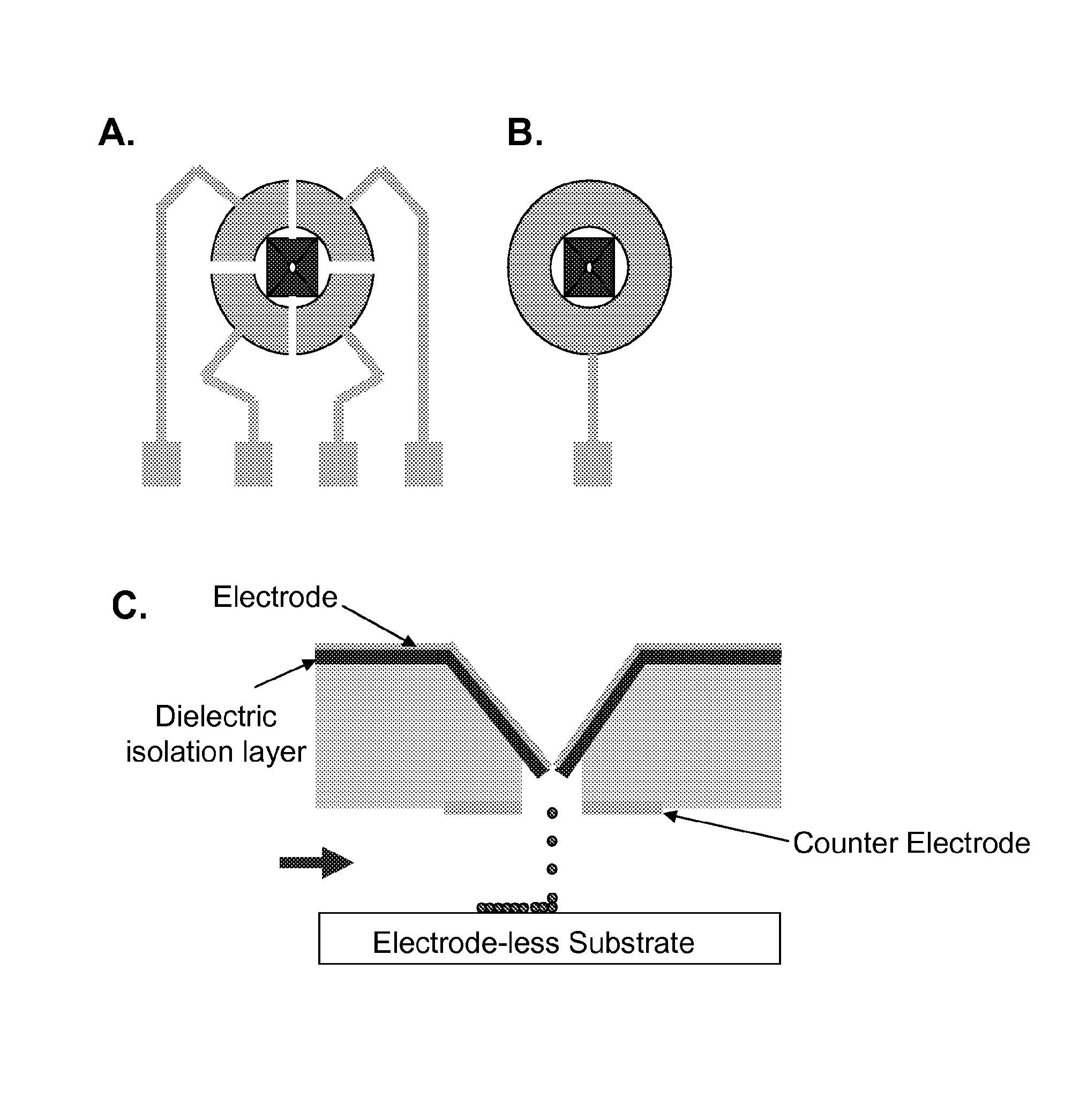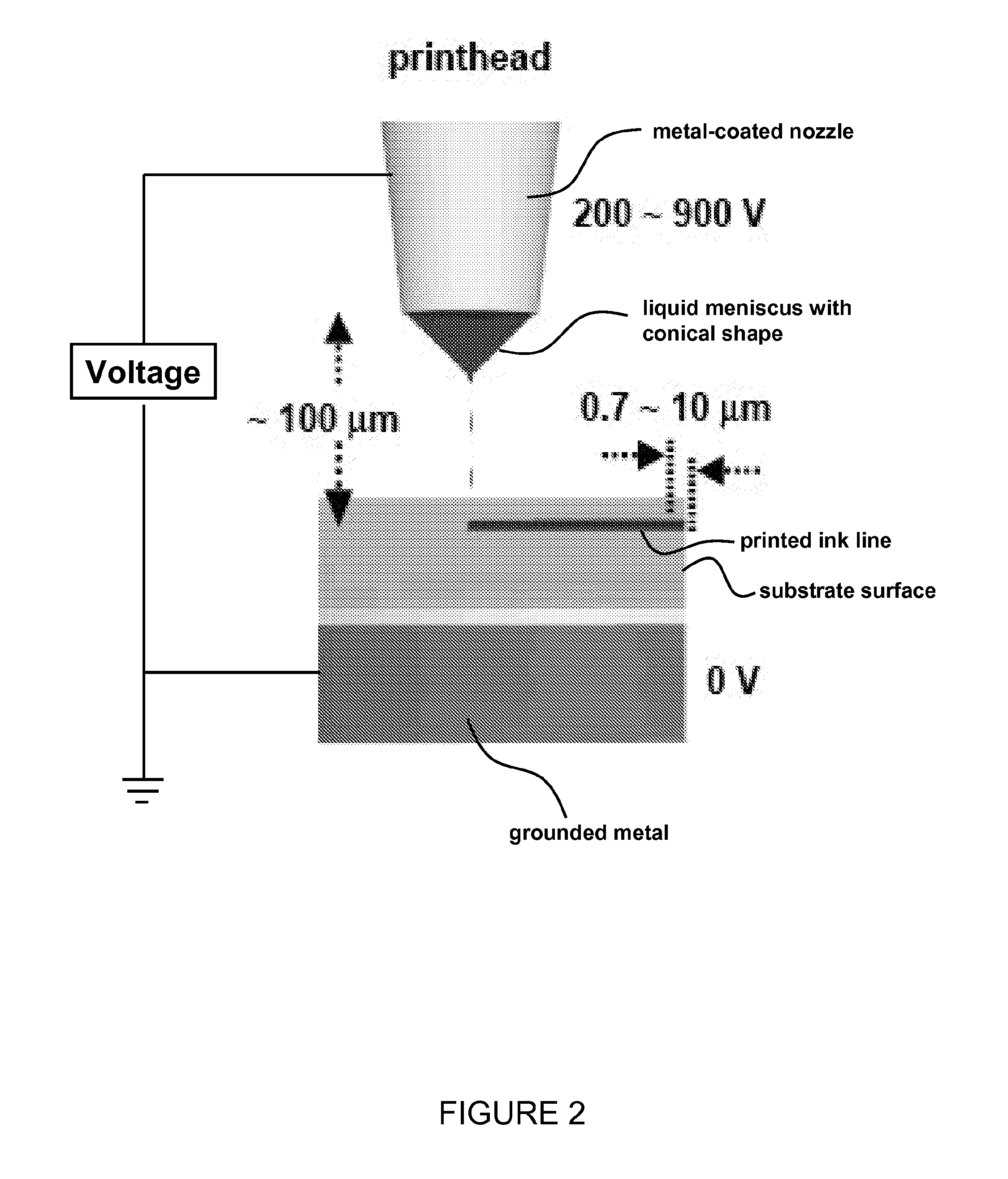High resolution electrohydrodynamic jet printing for manufacturing systems
a technology of electrohydrodynamic jet printing and manufacturing system, which is applied in the direction of printing, etc., can solve the problems that traditional ink jet printing methods are inherently limited with respect to applications requiring high resolution, and achieve the effect of high placement accuracy
- Summary
- Abstract
- Description
- Claims
- Application Information
AI Technical Summary
Benefits of technology
Problems solved by technology
Method used
Image
Examples
example 1
High Resolution E-jet System and Process Overview
[0094]Efforts to adapt and extend graphic arts printing techniques for demanding device applications in electronics, biotechnology and microelectromechancial systems have grown rapidly in recent years. This example describes the use of electrohydrodynamically-induced fluid flows through fine microcapillary nozzles for jet printing of patterns and functional devices with sub-micron resolution. Key aspects of the physics of this approach, which has some features in common with related but comparatively low-resolution techniques for graphic arts, are revealed through direct high speed imaging of the droplet formation processes. Printing of complex patterns of inks, ranging from insulating and conducting polymers, to solution suspensions of silicon nanoparticles and rods, to single walled carbon nanotubes, using integrated, computer-controlled printer systems illustrates some of the capabilities. High resolution, printed metal interconnec...
example 2
Printed Electronics
[0148]Printed electronics represents an important application area that can take advantage of both the extremely high-resolution capabilities of e-jet as well as its compatibility with a range of functional inks. To demonstrate the suitability of e-jet for fabricating key device elements in printed electronics, we pattern complex electrode geometries for ring oscillators, source / drain electrodes for transistors, and manufacture working transistors. In these examples, a photocurable polyurethane precursor provides a printable resist layer for patterning metal electrodes by chemical etching. The printhead in this case uses a 1 μm ID nozzle; the printing speed is 100 μm s−1. The substrate consists of a SiO2(300 nm) / Si coated uniformly with Au (130 nm) and Cr (2 nm). FIG. 9a shows a pattern of printed polyurethane after curing by exposure to ultraviolet light (˜1 J cm−2). The resolution is 2±0.4 μm, as defined by the minimum line widths. Much larger features, shown he...
example 3
Scanned Nozzles
[0153]Printing of active and passive materials using scanned small-diameter nozzles represents an attractive method for organic electronics and optoelectronics, partly because the high level of sophistication of similar systems used in graphic arts. Because of the additive nature of the process, materials utilization can be high. The materials can be deposited either in the vapor or liquid phase using respectively vapor jet printing or inkjet methods. While organic vapor jet printing techniques have been introduced only very recently, inkjet printing techniques are well-established and already have worldwide applications. In 2004, a 40-inch full-color OLED display prototype was fabricated using inkjet printing of light emitting polymers.317 The following summarize recent developments in inkjet printing techniques applied to the fabrication of organic optoelectronic devices.
[0154]Nozzles can be used to print liquids. Beginning shortly after the commercial introduction ...
PUM
 Login to View More
Login to View More Abstract
Description
Claims
Application Information
 Login to View More
Login to View More - R&D
- Intellectual Property
- Life Sciences
- Materials
- Tech Scout
- Unparalleled Data Quality
- Higher Quality Content
- 60% Fewer Hallucinations
Browse by: Latest US Patents, China's latest patents, Technical Efficacy Thesaurus, Application Domain, Technology Topic, Popular Technical Reports.
© 2025 PatSnap. All rights reserved.Legal|Privacy policy|Modern Slavery Act Transparency Statement|Sitemap|About US| Contact US: help@patsnap.com



